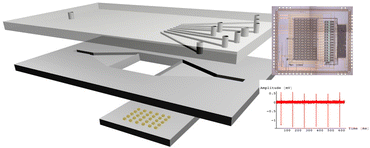Characterization of a microfluidic dispensing system for localised stimulation of cellular networks†
Abstract
We present a 3-D microfluidic device designed for localized

* Corresponding authors
a University of Neuchâtel, Institute of Microtechnology, Rue Jaquet-Droz 1, 2000 Neuchâtel, Switzerland
b Groningen Research Institute of Pharmacy, University of Groningen, The Netherlands
c ETH Zurich, Physical Electronics Laboratory, Zurich, Switzerland
d Institute of Industrial Science, University of Tokyo, Japan
We present a 3-D microfluidic device designed for localized

 Please wait while we load your content...
Something went wrong. Try again?
Please wait while we load your content...
Something went wrong. Try again?
T. Kraus, E. Verpoorte, V. Linder, W. Franks, A. Hierlemann, F. Heer, S. Hafizovic, T. Fujii, N. F. de Rooij and S. Koster, Lab Chip, 2006, 6, 218 DOI: 10.1039/B511768B
To request permission to reproduce material from this article, please go to the Copyright Clearance Center request page.
If you are an author contributing to an RSC publication, you do not need to request permission provided correct acknowledgement is given.
If you are the author of this article, you do not need to request permission to reproduce figures and diagrams provided correct acknowledgement is given. If you want to reproduce the whole article in a third-party publication (excluding your thesis/dissertation for which permission is not required) please go to the Copyright Clearance Center request page.
Read more about how to correctly acknowledge RSC content.
 Fetching data from CrossRef.
Fetching data from CrossRef.
This may take some time to load.
Loading related content
